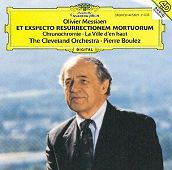Orquesta de Cleveland; Pierre Boulez.
Deutsche Grammophon 445827-2 [57'48"]

|
Olivier MESSIAEN: Et exspecto resurrectionem mortuorum (1964); La ville d'en haut (1987); Chronochromie (1959�1960). Orquesta de Cleveland; Pierre Boulez. Deutsche Grammophon 445827-2 [57'48"] |
 |
| Gramophone |
Boulez spoke, in his conversation with SP in last month's issue, of his pleasure at performing Messiaen with an orchestra relatively unfamiliar with his music. It sounds as though the Cleveland Orchestra must have enjoyed it too. You would expect them to, perhaps, in such a passage as that in the fourth movement of Et exspecto, where the two superimposed plainchant melodies return together with the noble �theme of the depths� �it has great splendour, as does the chorale melody of the finale, rising at the end to a satisfyingly palpable fffff. And in this performance of Chronochromie you can hear why Messiaen said that certain pages of it were �a double homage to Berlioz and Pierre Schaeffer [the French pioneer of electronic music]�. But I would imagine that the Cleveland players and Boulez have also enjoyed working on the really awkward passages of these scores. I have in mind the beginning of the second movement of Et exspecto, where Messiaen rather perplexingly remarked that the character of the melody is defined by the way the notes decay, not by their attack. What he meant, I suspect, was that the work was written to be played in the Sainte-Chapelle in Paris, and in this passage he deliberately used the building's cavernous acoustic. Boulez, who conducted the second performance in the much drier Theatre de l'Odeon, knows perfectly well that this moment needs immaculate phrasing and subtle control of dynamics if the effect is not to be lost, and he and his players manage it ideally.
In the penultimate section of Chronochromie, that famous or notorious �Epode� in which 18 string players impersonate different birds, the problems of clarity and precision are obviously extreme, and they are expertly negotiated here, but a feeling that time has stopped also needs to be conveyed (it is for this reason, probably, that Messiaen quite uncharacteristically estimated the duration of this passage as �a good ten minutes� here it takes less than half that). And it is, no doubt because by the time they came to record it the players were no longer gritting their teeth and counting like mad, but really enjoying their participation in a dawn chorus.
Absolute rhythmic precision and the clarity of colour that comes from meticulous balance are among the other pleasures of these performances. They make a most satisfying coupling, too, and not only for admirers of Messiaen: the most obvious �encore� after following the development of richly harmonized melody from the �Antistrophes� of Chronochromie through Et exspecto to the huge chorale of La ville d'en haut would be a performance of Boulez's own monumental Rituel. The recordings are excellent: clean but not clinical and ample in dynamic range.
|
|